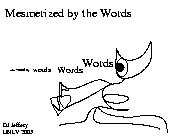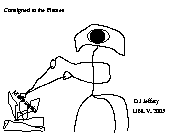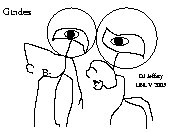The usual daily plan is that yours truly will lecture for 40 minutes or so.
Then we will have a break for 10 or so minutes.
Then we resume with the journal club reports for 25 or so minutes:
- Typically a person (a student or the instructor) or maybe sometimes 2 persons will read enough of some current article on cosmology (for Ast727: Cosmology) or galaxies (for Ast729: Galaxies) to report something of the main results. You just need to get enough from the article to report something that you find interesting.
- The topics of cosmology and galaxies strongly overlap and, in fact, almost all galaxies topics can be considered cosmology though the reverse is NOT true.
- The person reports on his/her article for 15 or so minutes with discussion. It often goes longer.
- If you are a second person reporting and don't get a chance to talk because the first report dragged on, we just hold the report over the for next day.
- Yours truly keeps lists of cosmology and galaxies reviews and articles from arXiv that seemed somehow interesting: see Cosmology & Galaxies Articles: Reviews and Cosmology and Galaxies Articles: Significant/Useful Articles. The reviews hopefully have lasting value. You can use those lists or find your own article.
- I suggest that you try to find short review articles or especially hot articles and avoid quantum cosmology which is a really deep for us, unless its quantum cosmology made easy.
- I'll just ask for volunteers on a day for the next day.
- Since there are typically 6 students and 1 instructor and about 30 lecture periods, we might each speak about 4 to 5 times or so, but there is no set number.
- Giving reports and participating the discussions is 20 % of grade and everyone gets that with a fair effort.
- The reports are intended to be low anxiety and maximum fun.
- Cosmology Introduction
This is the course website / extended syllabus for a course on cosmology.For nuts and bolts details of the course, see Syllabus: Short Version. For the official description, see Ast727: Cosmology.
-
Note all topics in the official description
(Ast727: Cosmology)
are covered though some at very introductory level in
Cosmology 1: History of Cosmology, General Relativity, Black Holes, Galaxies, CMB Fluctuations.
The plan for the course is to cover my own lecture pdf notes and other complementary material for cosmology which are linked below.
A supplementary source is the cosmology book Liddle (2015) (by Andrew Liddle (1965--)). You do NOT need to buy Liddle (2015) since you can read it online: ProQuest: Ebook Central: Liddle (2015).
The material we cover is at a rather elementary level for graduate course. But this allows us to build up from the bottom.
But we will also have journal club reports which makes us surf current research in cosmology. This allows us to build down from the top.
We will never meet in the middle.
The alternative is to grind through a solid textbook, but for non-specialists that would probably be unmemorable---and difficult for a non-specialist instructor.
Note that the Cosmology Course and Galaxies Course are good complements to each other. In fact, yours truly considers them both courses on cosmology, just with different emphases: the first on overall universal features and the second on the large scale structure of the observable universe.
Note also that the Cosmology Course is a good complement to Carl Haster's Ast734: Relativity and Gravitation: this is an easy course and that is hard course, but there is some overlap.
This is a relatively easy graduate course.
- Cosmology Lectures
- Cosmology 1: History of Cosmology, General Relativity, Black Holes, Galaxies, CMB Fluctuations:
Homework 1, Solution 1
- In-class lecture: History of Cosmology: A online popular lecture. There are some notes with the images, but there is NO complete narrative. It gives an overview and it's traditional to start cosmology in the manner of Carl Sagan (1934--1996).
- Required reading and homeworks:
- IAL 4: History of Astronomy to Newton (OK for what it is).
- IAL 25: Black Holes: Covers a bit on general relativity (GR) and active galaxies. Yours truly will add some questions from this lecture to Homework 1 in a later semester, sine die.
- IAL 26: The Discovery of Galaxies (OK for what it is).
- IAL 28: Galaxies (low-cal and a bit dated).
- IAL 29: The Large-Scale Structure of the Universe (low-cal and a bit dated).
- IAL 30: Cosmology.
- Cosmos 2: Miscellaneous Math Problems (do ONLY problem 7 since its of general interest): Homework 2, Solution 2, No notes.
- Cosmos 3a: Gravity, the Cosmological Constant, Inertial Frames: Homework 3, Solution 3, Notes 3a: 2023oct08, Notes 3b: 2023oct08.
- Cosmos 3b: The Friedmann Equation and its Simpler Solutions: Homework 3, Solution 3, Notes 3a: 2023oct08, Notes 3b: 2023oct08.
- Cosmos 4: Cosmological Geometry, Redshift, and Distance Measures: Homework 4, Solution 4, Notes 4: 2023oct24.
Exam 1 solutions: The questions are somewhat updated from the exam.
- Cosmos 5: The Friedmann Equation and its More Advanced Solutions: Homework 5, Solution 5, Notes 5: 2023oct31.
See also supplement Cosmos 5: Cosmological Constant Models, Dark Energy, and the Λ-CDM Model.- Cosmos 6: The Cosmic Background Radiation, the Cosmic Temperature, and Recombination: Homework 6, Solution 6, Notes 6: 2023dec12.
See also supplement Cosmos 6: The Cosmic Background Radiation, the Cosmic Temperature, and Recombination.- Cosmos 7: Bayesian Analysis: Homework 7, Solution 7, Notes 7: 2023dec21.
See also supplement Cosmos 7: Bayesian Inference and Constraining Cosmological Models and An Education Note on Bayesian Analysis in Dialogue Form.- Cosmos 8: Matter Power Spectrum, Etc.: NOT covered.
- Cosmos 9: Quantum Cosmology: NOT covered, except for a very superficial coverage of inflation in Cosmology 1: History of Cosmology, General Relativity, Black Holes, Galaxies, CMB Fluctuations and maybe somewhere else.
UNDER RECONSTRUCTION BELOW
- Cosmos 8: The Age of the Universe: Homework 8, Solution 8:
- Cosmos 9: The Density of the Universe and Dark Matter: Homework 9, Solution 9:
Required reading: Liddle, Ch. 9.- Cosmos 11: The Early Universe: Homework 11, Solution 11: which don't exist so far:
- Cosmos 12: Nucleosynthesis: The Origin of the Light Elements: Homework 12, Solution 12: which don't exist so far:
Required reading: Liddle, Ch. 12 / Liddle, Ch. 12: Direct link.- Cosmos 13: The Inflationary Universe: Homework 13, Solution 13: which don't exist so far:
Required reading: Liddle, Ch. 13 / Liddle, Ch. 13: Direct link.- Cosmos 14: The Initial Singularity: Homework 14, Solution 14: which don't exist so far:
Required reading: Liddle, Ch. 14 / Liddle, Ch. 14: Direct link.- Cosmos 15: Overview: The Standard Model of Cosmology: Homework 15, Solution 15: which don't exist so far:
Required reading: Liddle, Ch. 15 / Liddle, Ch. 15: Direct link.- Cosmos 16: Structures in the Universe: Homework 16, Solution 16: which don't exist so far:
Required reading: Liddle, AT 1-5: Also for completeness:- Liddle, AT 1: Direct link: General Relativistic Cosmology.
- Liddle, AT 2: Direct link: Classic Cosmology: Distances and Luminosities.
- Liddle, AT 3: Direct link: Neutrino Cosmology.
- Liddle, AT 4: Direct link: Baryogenesis.
- Liddle, AT 5: Direct link: Structures in the Universe.
- Cosmology Lectures
- Galaxies Introduction
This is the course website / extended syllabus for a course on galaxies.For nuts and bolts details of the course, see Syllabus: Short Version. For the official description, see Ast729: Galaxies.
There might be some changes since the course still in development.
The plan for the course is to cover Cimatti et al.: Introduction to Galaxy Formation and Evolution: From Primordial Gas to Present-Day Galaxies (2020): hereafter, just Cimatti (See also Cimatti et al. 2019: ArXiv posted intro chapter.) Chapters 3--11. I leave just as readings Chapter 1 (which is introductory) and Chapter 3 (which cosmology per se and so is really part of the Cosmology Course). Cimatti seems to be a fairly broad, gentle introduction to galaxies.
In fact, I plan to lecture on only certain aspects of the chapters in Cimatti where it seems useful to expand on what Cimatti says.
Note Cimatti is a "required" textbook and yours truly thinks it is a reasonable investment, but in many respects it will be dated in a few years and it already is a bit and it has NO problem bank. However, if a student feels they do NOT need Cimatti and can rely on class notes and relevant articles (see extended syllabus section Galaxies Lectures), they can do without the textbook.
In addition to lectures based on Cimatti, we will also have journal club reports which makes us surf current research in galaxies. This allows us to build down from the top.
We will never meet in the middle.
Note that the Cosmology Course and Galaxies Course are good complements to each other. In fact, yours truly considers them both courses on cosmology, just with different emphases: the first on overall universal features (i.e., cosmology per se) and the second on the large scale structure of the observable universe.
This is a relatively easy graduate course.
- Galaxies Lectures
- Introduction to galaxies
and 2. Introduction to cosmology
corresponding roughly to Cimatti chapters 1 & 2:
- Covered in class and required readings/homeworks:
- IAL 26: The Discovery of Galaxies (OK for what it is): Homework 26; Solutions 26.
- IAL 28: Galaxies (low-cal and a bit dated): Homework 28; Solutions 28. We just cover the galaxy rotation curves and galaxy quenching.
- IAL 29: The Large-Scale Structure of the Universe (low-cal and a bit dated): Homework 29; Solutions 29. We just cover the large scale structure of the observable universe and NOT the recapitulations.
- Not covered in class, but required readings/homeworks:
- IAL 4: History of Astronomy to Newton: Homework 4; Solutions 4.
- IAL 30: Cosmology: Homework 30; Solutions 30.
- Cimatti: Chapters 1 and 2: A required reading if you have bought the textbook. No homeworks.
- Optional reading.
- History of Cosmology: A online popular lecture. There are some notes with the images, but there is NO complete narrative.
- Exact Friedmann equations solutions: See p. 25? for the matter-Λ universe solution x(τ) and τ(x).
- Galaxies 3: Cosmic Present Galaxies as a Benchmark for Galaxy Formation and Evolution: Homework 23, Solution 23, Notes 3: 2024feb20.
- Cimatti: Chapter 3: A required reading if you have bought the textbook.
- log_log_plot_dj_4.html: A general discussion is given of logarithms and astronomical magnitude system.
- Keywords:
early-type galaxies (ETGs),
equivalent width,
full width at half maximum (FWHM),
galaxy,
galaxy color-magnitude diagram
(blue cloud galaxy,
galaxy bimodality,
green valley galaxy,
red sequence galaxy),
hydrogen (H)
(hydrogen anion (H-),
hydrogen ion (H+,H-),
hydride (H-),
hydron (H+)),
late-type galaxies (LTGs, AKA star-forming galaxies (SFGs),
lognormal distribution,
luminosity function (LF)
(Schechter
luminosity function (Schechter function)),
Sersic profile,
spectral energy distribution (SED,
luminosity per frequency/wavelength)
(radiant flux,
spectra flux density
(luminosity per frequency/wavelength per area),
surface brightness,
Wolf-Rayet star (WR star),
etc.
- Galaxies: Lecture 3: Relevant Articles
- Galaxies 4: Cosmic Present Star Forming Galaxies (SFGs): Homework 24, Solution 24, Notes 4: 2024mar18.
- Cimatti: Chapter 4: A required reading if you have bought the textbook.
- Keywords:
dark matter halos,
early-type galaxies (ETGs),
galaxy,
galaxy color-magnitude diagram
(blue cloud galaxy,
galaxy bimodality,
green valley galaxy,
red sequence galaxy),
hydrogen (H)
(atomic hydrogen (H_I),
molecular hydrogen (H_2)),
star-forming galaxies (SFGs) (AKA late-type galaxies (LTGs),
luminosity function (LF)
(Schechter luminosity function (Schechter function)),
Sersic profile,
surface brightness,
X-factor (AKA XCO factor),
etc.
- Galaxies: Lecture 4: Relevant Articles
- Galaxies 5: Early Type Galaxies (ETGs): Homework 25, Solution 25, Notes 5: 2024apr02.
- Cimatti: Chapter 5: A required reading if you have bought the textbook.
- Keywords:
dark matter halos,
early-type galaxies (ETGs),
galaxy,
galaxy color-magnitude diagram
(blue cloud galaxy,
galaxy bimodality,
green valley galaxy,
red sequence galaxy),
hydrogen (H)
(atomic hydrogen (H_I),
molecular hydrogen (H_2)),
star-forming galaxies (SFGs) (AKA late-type galaxies (LTGs),
luminosity function (LF)
(Schechter luminosity function (Schechter function)),
Sersic profile,
surface brightness,
virial theorem
(virial theorem <T>=-(1/2)∑kk<Fk·rk>,
virial theorem <T>=(1/2)∑kk<Uk>,
virial theorem <T>=-(1/2)<U_gravity>),
etc.
- Galaxies: Lecture 5: Relevant Articles
- Galaxies 6: Cosmic Present Galaxy Environments: Interactions, Groups, Clusters, Superclusters, Large-Scale Structure: Homework 26, Solution 26, Notes 6a: 2024may05, Notes 6b: 2024may05.
- Cimatti: Chapter 6: A required reading if you have bought the textbook.
- galaxy files: See especially
local_group.html,
etc.
- Keywords:
baryonic dark matter,
dark matter,
dark matter halos,
galaxy clusters,
galaxy groups,
galaxy groups and clusters,
galaxy superclusters,
interacting galaxies
large-scale structure of the universe,
merging galaxies,
Local Group of Galaxies,
N-body simulation,
etc.
- Galaxies: Lecture 6: Relevant Articles
- Galaxies 7: Formation, Evolution, and Properties of Dark Matter Halos : Homework 27, Solution 27, Notes 7: 2024jan01.
- Cimatti: Chapter 7: A required reading if you have bought the textbook.
- Online lecture: An Educational Note on Quasi-Equilibrium Dark Matter Halo Physics. The direct link is 080_dark_matter_halo.pdf
- Keywords:
baryonic dark matter,
Burkert profile,
dark matter,
dark matter halos,
MOND (MOdified Newtonian Dynamics),
N-body simulation,
NFW profile (Navarro-Frenk-White profile),
r_200,
radial-acceleration relation (RAR)),
Sersic profile,
virial theorem
(virial theorem <T>=-(1/2)∑kk<Fk·rk>,
virial theorem <T>=(1/2)∑kk<Uk>,
virial theorem <T>=-(1/2)<U_gravity>),
etc.
- Galaxies: Lecture 7: Relevant Articles
- Acronyms:
- AGB: asymptotic giant branch (AGB) stars.
- AGN: active galaxy nuclei (AGNs)
- GAMA: Galaxy And Mass Assembly survey (GAMA)
- luminosity function (LF)
- SMF: stellar mass function (SMF, faute de mieux):
- WNM: warm neutral medium (faute de mieux).
- See Keywords: galaxies in the insert below (local link / general link: keywords_galaxies.html).
EOF
- See Galaxy Classification Systems and Types of Galaxies in the insert below (local link / general link: galaxy_types.html):
- Covered in class and required readings/homeworks:
- Galaxies Lectures
The evaluation summary is in the table below.
__________________________________________________________________________
Table: Evaluations Items
__________________________________________________________________________
Item Percentage Drops Comment
of grade
__________________________________________________________________________
Readings 0 % For study
Homeworks 0 % The study guide
journal club reports 20 % 2 drops 1 mark point each
2 in-class tests 40 % no drops
comprehensive final 40 % no drops
extra credit 0 % There is NO extra credit
__________________________________________________________________________
-
Tentative test schedule: Test 1: Oct09, Test 2 Nov13,
Final: See date and time specified at the
academic calendars site.
- Readings are NOT marked but you should do them.
- Homeworks are the study guide. The solutions will posted when the homeworks are posted. Yours truly is making them up as we go along. Try really hard before looking at the solutions. Self-testing is the key to test preparations. Report any mistakes that you find.
- Journal club reports: ∼ 10 reports. We'll try to get everyone to have the same number of reports, but allow 2 drops if the number reports is not quite the same at the end of the semester.
- The in-class tests will be out of 50 marks and consist of two parts:
- 10 multiple-choice questions intended as easy warm-up questions worth 2 marks each.
- 3 full-answer questions worth 10 marks each. Two of these will be drawn from the homeworks, maybe cut-down a bit for test mise-en-scene. The third question will be new if yours truly can think of one.
- The final is 2-hour comprehensive final and will probably be 20 multiple-choice questions intended as easy warm-up questions worth 2 marks each and 5 or so full-answer questions with 3 or 4 drawn from the homeworks, maybe cut-down a bit for test mise-en-scene.
Yours truly does NOT use a fixed scale for letter grades. I just draw my own lines where I see fit at the end of the semester.
Until the end of the semester, I just use a curve which fixes the GPA at about 3.
I don't use WebCampus. I just post grades under anonymous aliases.
You can choose your own alias. It has to be absolutely NOT identifiable as anyone.
See Amazon books, Library Search, and NASA ADS search.
- Andrea Cimatti (Author), Filippo Fraternali (Author), Carlo Nipoti (Author), 2019, 582 pages, Cambridge Univ. Pres, "Introduction to Galaxy Formation and Evolution: From Primordial Gas to Present-Day Galaxies": It seems to cover cosmology at about the level of Liddle (2015), but also all of galaxy formation and evolution. It has NO problems. I've a copy and may use it in the future for both Ast727: Cosmology and Ast729: Galaxies.
- Coles, Peter; Lucchin, Francesco, 2002, 520 pages, "Cosmology: The Origin and Evolution of Cosmic Structure": About the level for a grad course, but a bit dated.
- Mark H. Jones (Editor), Robert J. A. Lambourne (Editor), Stephen Serjeant (Editor), 2015, Cambridge - Open University, "An Introduction to Galaxies and Cosmology": More of undergraduate level and has problems.
- Kunze, Kerstin, 2016, arXiv, 36 pages, "An introduction to cosmology".
- Leclercq, Florent, et al. 2014, arXiv, 49 pages: "Cosmology: from theory to data, from data to theory": With Bayesian analysis.
- Andrew Liddle, 2015, "An Introduction to Modern Cosmology": See also Liddle (2015). You don't need to buy Liddle (2015) since you can read it online: ProQuest: Ebook Central: Liddle (2015). We can print from online. Are we allowed to print the whole thing over time? Maybe the server will let us, but 41 pages per user may be the legal limit.???? Can we use such printouts as a textbook for students?
- Mo, Houjun; van den Bosch, Frank; White, Simon, 2010, 840 pages, "Galaxy Formation and Evolution": See also Mo et al. Not at Library Search. See also stuff, stuff by Mo, and Bosch advertizement. It has NO problems.
- Ryden, Barbara, 2017, 300 pages, 4th year, "Introduction to Cosmology": 2nd edition well reviewed.
- Ta-Pei Cheng, 2010, 456 pages GR with some cosmology. Also Ta-Pei Cheng, 2015, 292 pages, "Relativity, Gravitation and Cosmology: A Basic Introduction":
- Weinberg, Steven, 2008, 616 pages, "Cosmology": Really tough going, but great.
- Universe in Problems:
- Solutions of Friedman equations in the Big Bang model: Problem 23: Positive-curvature-matter universe: Exact solution a(eta),t(eta), where eta is conformal time.
- Solutions of Friedman equations in the Big Bang model: Matter and radiation: Problem 5: exact solutions for matter and radiation: No analytic solutions for a(t), but there is one for t(a) using Hudson-5,28. See also INTEGRALS CONTAINING THE SQUARE ROOT OF ax+b.
- Solutions of Friedman equations in the Big Bang model: Problem 18: age of the Universe
- Solutions of Friedman equations in the Big Bang model: Problem 23: closed dusty Universe, exact solution: Closed matter cosine universe.
- Solutions of Friedman equations in the Big Bang model: Problem 41: power-law cosmologies: Single power-law solutions.
- Evolution of Universe: Problem 13: The Matter-Cosmological Constant Universe Solution: See also SOLUTION OF THE FRIEDMANN EQUATION DETERMINING THE TIME EVOLUTION, ACCELERATION AND THE AGE OF THE UNIVERSE (2007), Frank Steiner, p. 12.
- See also arXiv-astro-ph/recent for the latest cosmology articles.
- arXiv-quant-ph/recent
- Astronomy My own online astro encyclopedia: no longer updated since Wikipedia has long surpassed it.
- Astrophysical Journal (ApJ)
- Books
- Eddie Baron's galaxies and cosmology course site
- Introductory Astronomy Web Lectures (IAWL) See, in particular, IAL: Cosmology.
- Christian Knobel Intro Cosmolgy, 2012 An introduction into the theory of cosmological structure formation, 2012, 102 pages. Seems good, current as of 2012.
- Lawden 2002 special relativity: Preface, Chapters 1--3. A good, quick introduction.
- Max Pettini: Physcial Cosmology Seems a good quick intro
in pdf lectures which are probably intended to be much like real lectures. Seems to be current as of
2012.
- Basic Concepts
- Newtonian Cosmology
- Relativistic Cosmology
- World Models
- Redshifts and Distances in Cosmology
- The Hubble Diagram of Type Ia Supernovae: Evidence for a Cosmological Constant
- Large Scale Structure
- Clusters of Galaxies: Spherical Collapse and Virialization
- The Intergalactic Medium On reionization and all that.
- Absorption Line Formation and the Curve of Growth
- Physical Properties of Lyman Alpha Forest Clouds
- Cosmological Implications of the Lyman Alpha Forest. I: The Repository of Most of the Baryons
- The Ionizing Background
- Gravitational Lensing
- Weak Gravitational Lensing
- Observational Tests of Big Bang Nucleosynthesis
- Mermin 1968 special relativity: Wow your friends with special relativity paradoxes and solutions.
- NASA ADS
- Nature
- Physics Links Look-up pages mainly. Not updated recently.
- Sean Carroll Lecture Notes on General Relativity, 1997
- Science
- Scientific American The inner circle SciAm.
- Wikipedia
-
 Alien mesmerized by words.
Alien mesmerized by words.
-
 Earthrise from Apollo 11, 1969jul16.
Credit:
NASA.
Earthrise from Apollo 11, 1969jul16.
Credit:
NASA.
 Well not quite.
Well not quite.
 Beware of aliens bearing grades.
Beware of aliens bearing grades.
Very reassuring I think.
- Historical intro similar to cosmology:
- IAL 4: The History of Astronomy to Newton Essentially, the history of cosmology from prehistory to Isaac Newton (1643--1727) including Newton's work.
- IAL 26: The Discovery of Galaxies A partial history of cosmology from Isaac Newton (1643--1727) to the 1920s.
- IAL 31: Cosmology Gives a brief history of cosmology in the 20th century.
- Wikipedia
- Wikipedia: Chronology of the universe
- Wikipedia: Graphical timeline from Big Bang to Heat Death Note that the left-hand vertical scale is tricky, for greater than about > 0, it is x=100*log(log(t_year)) and so t_year=10**(10**(x/100))).
- Wikipedia: Graphical timeline of the Stelliferous Era Note the vertical axis is tricky, but it was it says, log(y) where y is the number of years and then multiply by 10. Thus 10**6 years is 10*log(10**6)=10*6=60. Gollee as Gomer Pyle would say.
- List of cosmologists Sean, Ron, Avi, Saul, Adam, Brian, and Dave Schramm made the list, but not Ken and Bob.
- Wikipedia: Timeline of cosmological theories
- Friedmann equations and Elementary Solutions,
Parameters of Cosmology,
Cosmological Distance Measures:
- Christian Knobel Intro Cosmolgy, 2012, p. 9ff But Knobel expects you to know some general relativity before you begin. Gory.
- David Jeffery: Cosmological Distance Measures Explained It needs a lot of revision that it will probably never get.
- David Hogg: Distance Measures in Cosmology See also the article version Hogg, 2000, Distance Measures in Cosmology.
- Max Pettini 1: Basic Concepts
- Max Pettini 2: Newtonian Cosmology He derives the Friedmann equations from Newtonian physics plus special assumptions.
- Max Pettini 3: Relativistic Cosmology
- Max Pettini 5: Redshifts and Distances in Cosmology
- Sean Carroll Lecture Notes on General Relativity, 1997, Lecture 8, Cosmology But this is the end of his lectures, and so they assume you know all intro general relativity.
- Wikipedia
- Cosmological horizons:
- Thermal history of the observable universe:
- Max Pettini: The Intergalactic Medium On reionization and all that.
- Max Pettini: Large Scale Structure It has some stuff on recombination
- Wikipedia
- Inflation and
Particle Physics in Cosmology:
- Pralavorio 2013 Particle Physics and Cosmology, Les Houches
- Silverstein 2013 Les Houches lectures on inflationary observables and string theory, Les Houches
- Wikipedia
- Cosmological Structure Formation:
- Christian Knobel Intro Cosmolgy, 2012, p. 55ff on general relativistic treatment of linear structure formation.
- Christian Knobel Intro Cosmolgy, 2012, p. 29ff
on Newtonian .
- Frenk & White (2012), Dark matter and cosmic structure A review with a historical perspective from the giants.
- Max Pettini: Large Scale Structure It has some stuff on Jeans instability.
- Wikipedia
- Power Spectrum:
- Wikipedia
- CMB: Primary anisotropy There is a angular power spectrum plot.
- linear structure formation
- nonlinear structure formation
- Wikipedia
- Nonlinear Structure Formation
- Bernardeau 2013 The evolution of the large-scale structure of the universe: beyond the linear regime, Les Houches.
- Tinker et al. (2008) Toward a Halo Mass Function for Precision Cosmology: The Limits of Universality.
- Wikipedia
- Press-Schecter Formalism
- Galaxy Formation
- Cosmic Microwave Background (CMB)
- Galaxy Dynamics
- Gravitational lensing